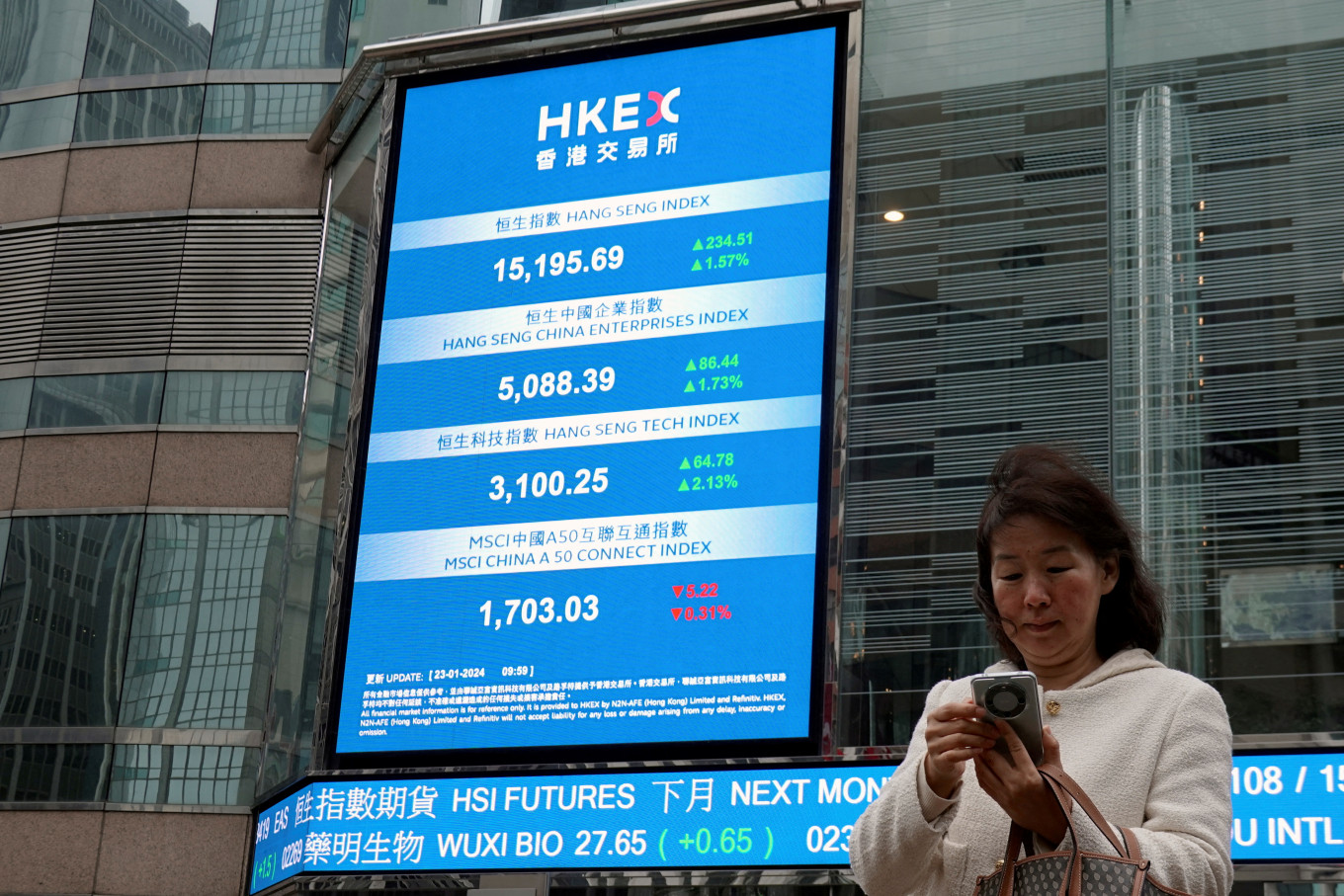Popular Reads
Top Results
Can't find what you're looking for?
View all search resultsPopular Reads
Top Results
Can't find what you're looking for?
View all search resultsAsia stocks gain, dollar drifts as inflation tests await
Change text size
Gift Premium Articles
to Anyone
A
sian stocks rose on Friday and were poised for the fourth month of gains, while the dollar drifted lower, keeping the yen steady as investors await inflation readings from Europe and the US that will likely dictate the path of interest rates globally.
A downward revision to consumer spending meant the US economy grew more slowly than expected in the first quarter, data showed on Thursday, weighing on Treasury yields and the dollar.
The economic data also stoked expectations that the Federal Reserve has scope to cut rates this year, with market pricing putting a September cut at a coin toss, CME tool showed. For the year, traders are pricing in 35 basis points of easing.
MSCI's broadest index of Asia-Pacific shares outside Japan rose 0.55 percent, pushing away from the three-week low hit on Thursday. The index is set for a 1.4 percent decline for the week but is up 2.7 percent in May, rising for the fourth straight month.
Japan's Nikkei was up 0.20 percent and is flat for the month. China stocks also rose, with the blue-chip index up 0.23 percent while Hong Kong's Hang Seng index spiking 1.3 percent higher.
The upturn in China's markets came even as the nation's manufacturing activity unexpectedly fell in May, an official factory survey showed on Friday. The soft outcome kept alive calls for fresh stimulus as a protracted property crisis continues to weigh on businesses, consumers and investors.
Financial markets have been biding their time for the main data event of the week - Friday's April report on US core personal consumption expenditures (PCE) price index, which is the Fed's preferred inflation gauge.
Tony Sycamore, market analyst at IG, said the market is taking a more cautious approach to the European and US PCE inflation data after upside surprises in Australia and German inflation reports earlier this week.
Federal Reserve policymakers continue to expect inflation to fall this year even as the labor market stays strong, leaving them in no hurry to cut the policy rate from the 5.25 percent-5.5 percent range they have kept it in since last July.
Elsewhere, traders are also warily looking over their shoulders for any hints of intervention from the Tokyo authorities as the Japanese yen flirts with levels that led to suspected bouts of intervention late in April and early this month.
The yen was last at 156.74 per dollar, having touched four-week lows of 157.715 on Wednesday. The currency weakened to its lowest in 34 years at 160.245 on April 29, sparking at least two suspected rounds of interventions.
The Japanese authorities have been relatively restrained in their recent verbal warnings, possibly waiting for weaker US economic data and a shift in Fed policy to support the yen, according to Charu Chanana, head of currency strategy at Saxo.
But with the Fed looking likely to cut rates only towards the end of the year, the frail yen has been caught in the crosshairs of the vast gap between US and Japan yields, with traders using the yen to fund their investments in higher yielding currencies.
Data on Friday showed core consumer prices in Japan's capital rose 1.9 percent in May on rising electricity bills but price growth excluding the effect of fuel eased, heightening uncertainty on the timing of the central bank's next interest rate hike.
"Even if the BOJ raises rates in June or July, the increase is expected to be minimal and unlikely to significantly close the gap with US interest rates," Chanana said, noting that movements in dollar/yen towards the 155 level could attract more carry trade interest.
The dollar index, which measures the US currency against six rivals, was at 104.77, on course for 1.5 percent decline in May, snapping a four-month winning streak.
The euro last fetched $1.0828 ahead of inflation report from euro zone that is set to influence the European Central Bank's policy path. The central bank is all but certain to cut rates in June but what comes after that remains uncertain.
Markets are pricing 60 basis points of ECB cuts this year.
In commodities, oil prices eased after a surprise build in US gasoline stocks weighed on the market. Brent futures was down 0.31 percent at $81.61 a barrel, while US West Texas Intermediate (WTI) crude was down 0.36 percent at $77.63.
Gold prices rose 0.12 percent to $2,345.93, on course for over 2 percent gain in May.











